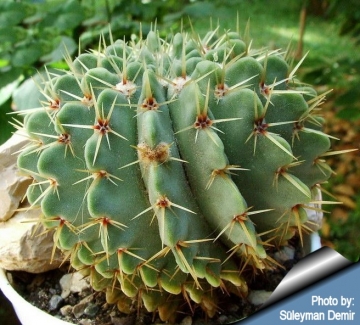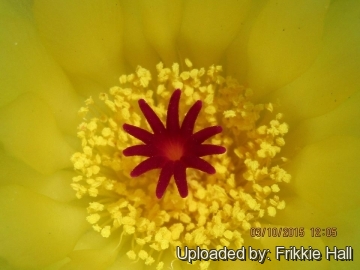
Parodia buiningii Photo by: Valentino Vallicelli
It is one of the most distinctive Notocacti, with a unique bright emerald green body, with many sharp ribs and large yellow flowers that open during the day and close at night.
Origin and Habitat: Southern Brazil, northern Uruguay
Synonyms:
See all synonyms of Parodia buiningii
back
Accepted name in llifle Database:Parodia buiningii (Buxb.) N.P.TaylorBradleya 5: 93 (1987)Synonymy: 6
back
Description: Parodia buiningiiSN|20510]]SN|20510]] (Buxbaum) N.P. Taylor is a solitary, flattened cactus only a few cm in height with long, straw-yellow spines. It bears large and showy yellow flowers, and produces hairy fruit and black seeds.
Stem: Simple, depressed-spherical to spherical, or oblate, , not woolly apically, grass green, pale grey, bluish to bright emerald green, up to 8 cm tall and 12 cm in diameter.
Ribs: About 16, pronounced, straight and sharp, up to 2 centimetres in height, with narrow blade-like tubercles between the areoles.
Areoles: Sunken under the tubercles, initially woolly, losing the wool as they mature.
Central spines: (3-)4, forming a cross, straight, stiff, yellowish or straw-coloured, dark brown at base 2-3 cm long.
Radial spines: 2-3, very similar to the centrals but smaller.
Flowers: 7 cm long, 8 cm in diameter, shiny, pale yellow with a distinct red-violet stigma. Pericarpel and tube with thick dark to light brown wool.
Blooming season: Summer.
Fruit: Elongating at base, up to 3 cm long.
Seeds: Helmet-shaped to 1.4 mm, finely tuberculate, matt black.
History: The species was first described as Notocactus buiningiiSN|20511]]SN|20511]] by F. Buxbaum in 1968, and was given its current name by N. P. Taylor in 1968, based on Buxbaum's earlier description. Despite remonstrance from hobbyists (among whom Notocactus species were popular) Notocactus (and others) have now been synonymised under Parodia.
Subspecies, varieties, forms and cultivars of plants belonging to the Parodia buiningii group
 Parodia buiningii (Buxb.) N.P.Taylor: has (usually) solitary, flattened stems only a few cm in height with straw-yellow spines. Flowers yellow. Fruits hairy. Seeds black. Distribution: Southern Brazil, northern Uruguay.
Parodia buiningii (Buxb.) N.P.Taylor: has (usually) solitary, flattened stems only a few cm in height with straw-yellow spines. Flowers yellow. Fruits hairy. Seeds black. Distribution: Southern Brazil, northern Uruguay. Parodia buiningii f. cristata hort.: crested form.
Parodia buiningii f. cristata hort.: crested form.
Bibliography: Major references and further lectures
1) Hunt, D., Taylor, N. and Charles, “The New Cactus Lexicon”} dh Books, Milborne Port, UK. 2006
2) Larocca, J., Machado, M. & Duarte, W. 2013. {{Parodia buiningii. The IUCN Red List of Threatened Species 2013: e.T152944A698169. http://dx.doi.org/10.2305/IUCN.UK.2013-1.RLTS.T152944A698169.en. Downloaded on 06 February 2016.
3) Edward Anderson “The Cactus family” Timber Press, Incorporated, 2001
4) James Cullen, Sabina G. Knees, H. Suzanne Cubey "The European Garden Flora Flowering Plants: A Manual for the Identification of Plants Cultivated in Europe, Both Out-of-Doors and Under Glass" Cambridge University Press, 11/Aug/2011
5) Wikipedia contributors. "Parodia buiningii." Wikipedia, The Free Encyclopedia. Wikipedia, The Free Encyclopedia, 26 May. 2014. Web. 6 Feb. 2016.
6) Hirao. “Colour Encyclopaedia of Cacti”, f. 449, 1979
7) Hecht. “BLV Handbuch der Kakteen”. 336, 1982
8) Eggli, U.; Nyffeler, R. "Proposal to Conserve the Name Parodia against Frailea (Cactaceae)". Taxon 47 (2): 475–6. 1998
9) Eggli, U.; Nyffeler, R. "Parodia allosiphon (Marchesi) N. P. Taylor (Cactaceae - Cactoideae) - a cladistically 'basal' species with a restricted distribution range. (Notes towards a checklist of Cactaceae of Uruguay". Bradleya 25: 37-44. 2007
 Parodia buiningii Photo by: Cactus Art
Parodia buiningii Photo by: Cactus Art Parodia buiningii Photo by: Peiffer Clement
Parodia buiningii Photo by: Peiffer Clement Photo and © copyright by Mladen Turcinovic (Croatia) Photo by: Cactus Art
Photo and © copyright by Mladen Turcinovic (Croatia) Photo by: Cactus Art Photo & © copyright by Süleyman Demir Turkey Photo by: Cactus Art
Photo & © copyright by Süleyman Demir Turkey Photo by: Cactus Art Photo & © copyright by Süleyman Demir Turkey Photo by: Cactus Art
Photo & © copyright by Süleyman Demir Turkey Photo by: Cactus Art Parodia buiningii Photo by: Paolo Di Varena
Parodia buiningii Photo by: Paolo Di Varena Parodia buiningii Photo by: Cactus Art
Parodia buiningii Photo by: Cactus Art Parodia buiningii Photo by: Frikkie Hall
Parodia buiningii Photo by: Frikkie HallCultivation and Propagation: This is an easy plant to cultivate. It likes to be kept cool, and needs only a short rest in winter. It can can tolerate light frost. Grow in full sun or light shade, but it doesn't like full, hot blazing sun in the central summer months. Water occasionally in winter so the roots do not dry out completely, and water regularly in summer. Some growers suggest to use exclusively rain water. But be careful, as it will rot easily if the substrate is wet and cold. It tends to lose its roots in winter. The root system of this plant is comparatively small, and it is best to grow it in a shallow pot using a neutral to slightly acidic compost, with plenty of extra grit. Give an occasional tonic of sequestrated iron.
Reproduction: Usually by seeds, as it seldom produces offsets.
Your Photos

by Valentino Vallicelli

by Cactus Art

by Valentino Vallicelli





















